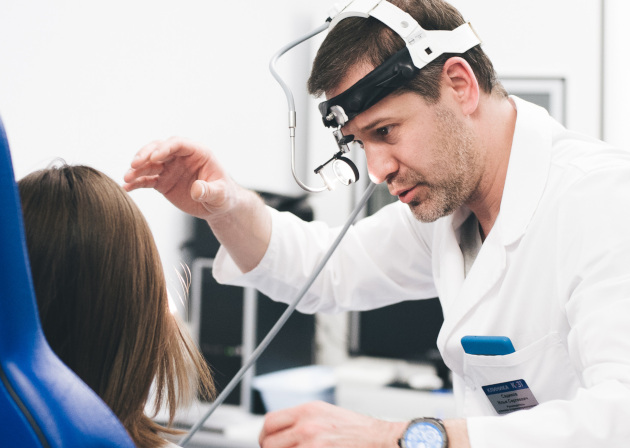Nasal repositioning
Nasal repositioning is a specific medical procedure. Its goal is to restore the anatomically correct position of the bone and cartilage structures of the nose after injury. It is performed to correct displacements and deformities caused by fractures.

Best
specialists
specialists

Expert
equipment
equipment

Advanced diagnostic
treatment
treatment

Restrictions
- Presence of severe swelling in the area of soft tissue or bones
- Signs of tissue necrosis or contamination
- Complicated cases (for example, when a broken nose is accompanied by a serious brain contusion)
- Problems with blood coagulation (this background increases the risk of bleeding during and after surgery)
- The presence of an active herpetic rash or inflammatory processes (the procedure increases the risk of infection)
General information about the procedure

How is an appointment with an otolaryngologist at K+31?
During the initial appointment, the doctor questions the patient in detail about complaints, clarifies the history of the disease, and lifestyle. Next, a thorough visual examination of the nose, pharynx, ear, and larynx is carried out. Special tests are prescribed to assess the acuity of hearing and smell.
Our doctors

2GIS Award
This award is given to clinics with the highest ratings according to user ratings, a large number of requests from this site, and in the absence of critical violations.

«Good place» according to Yandex
This award is given to clinics with the highest ratings according to user ratings. It means that the place is known, loved, and definitely worth visiting.

Our doctors are laureates of the ProDoctors Award
The ProDoctors portal collected 500 thousand reviews, compiled a rating of doctors based on them and awarded the best. We are proud that our doctors are among those awarded.
Make an appointment at a convenient time on the nearest date
Price
Otorhinolaryngologist primary appointment
from 5 460 ₽
Otolaryngologist repeated appointment
from 5 460 ₽
Reception of an otorhinolaryngologist at home in Moscow within the Moscow Ring Road
from 18 810 ₽
Planned remote online consultation of an otorhinolaryngologist using telemedicine technologies
Other services
Septoplasics - rectification of the nose partition
Audiometry
Endoscopic surgery
Receptoplasty (repeated operations)
Otoneurology
Snoring treatment
Nose valve surgery
Silent sinus syndrome treatment
Treatment of perforation of the nasal septum
Hearing aids
Voice surgery
Pneumomassage
Nasal block
Catheterization of the auditory tube
Washing the attic
Washing the lacunae of the tonsils

Appointment to the doctor
Fill out the form, our managers will contact you within 15 minutes
Our clinics
Didn't find the service you were looking for?
Call us!
+7 (495) 104-48-14
Write to whatsapp
Ask question


































Indications
The main objective of the operation is to restore the functionality and aesthetic appearance of the nasal area. It is prescribed in the presence of the following types of injuries:
Persistent deformities that develop after one and a half to two months due to improper fusion of bones can only be corrected with the help of osteotomy.